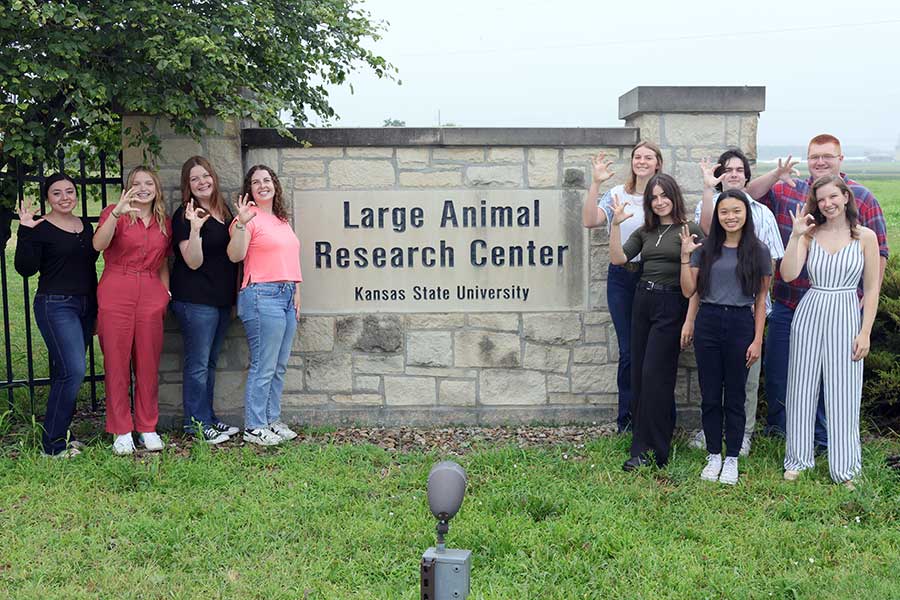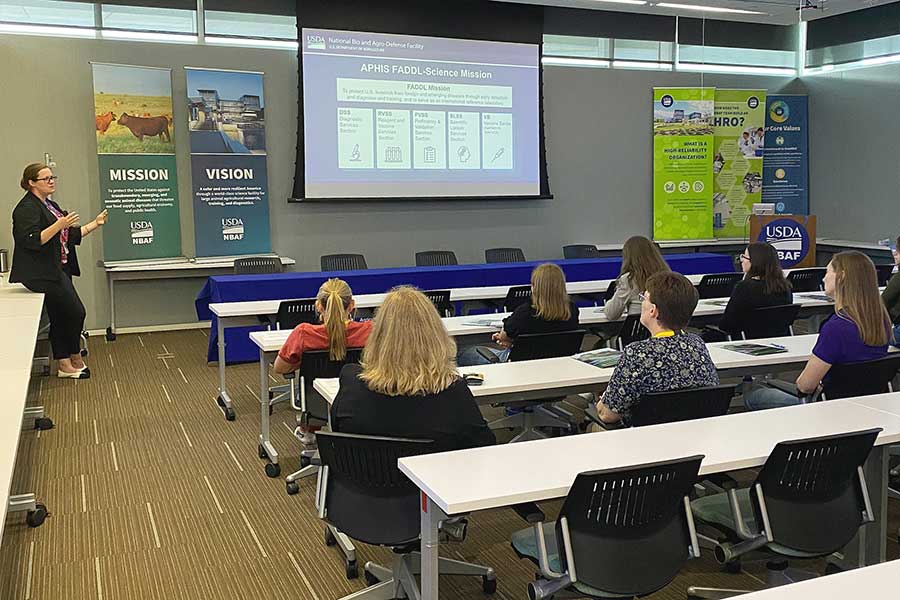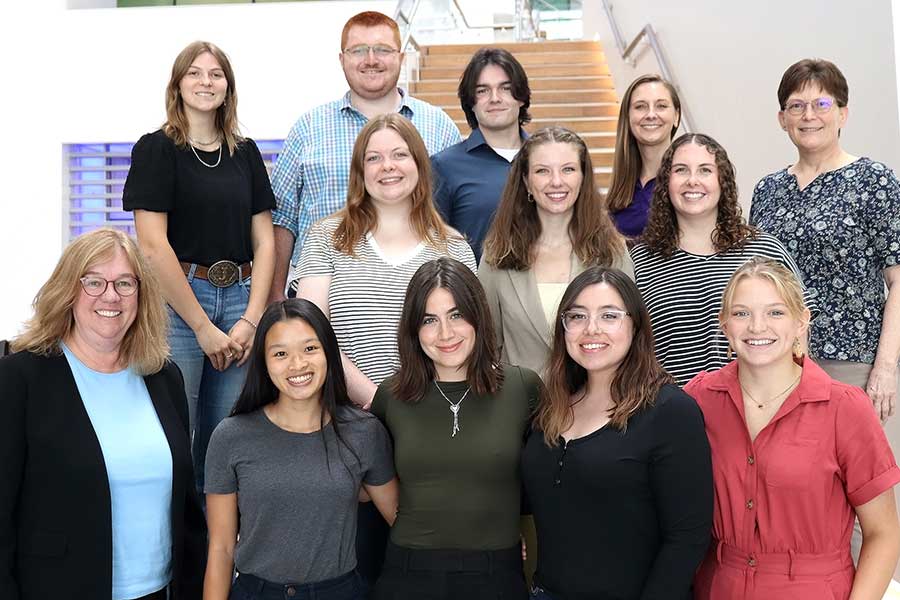K-State team trains future technicians in high-containment laboratory
The National Bio and Agro-Defense Facility, or NBAF, Laboratorian Training Program, or NLTP, just finished its sixth year of training the next generation of high-containment laboratory technicians.
Funded by the USDA, K-State partners with the Animal and Plant Health Inspection Service’s Foreign Animal Disease Diagnostic Laboratory, or FADDL, at NBAF in Manhattan, KS. Since 2020, NLTP also expanded to add programs to other universities.
Students spend three weeks learning about high-containment laboratory safety through an online K-State course. Once completed, they spend eight weeks at K-State’s Biosecurity Research Institute, or BRI, learning hands-on skills, including laboratory benchwork, large animal handling at the Large Animal Research Center and mosquito handling in the BRI’s mosquito rearing laboratory.
 Students in the NBAF Laboratorian Training Program visit the Large Animal Research Center at K-State. From left to right: Celina Arredondo, Gillian Struble, Olivia Kreutzer, Olivia Miller, Amara Johnson, Breck Aguinaga, Kaylie Kwan (front), Beck Fitzpatrick, Sophia Bonham (front), and Andrew Kohl.
Students in the NBAF Laboratorian Training Program visit the Large Animal Research Center at K-State. From left to right: Celina Arredondo, Gillian Struble, Olivia Kreutzer, Olivia Miller, Amara Johnson, Breck Aguinaga, Kaylie Kwan (front), Beck Fitzpatrick, Sophia Bonham (front), and Andrew Kohl.
Dr. Dana Vanlandingham, interim associate dean of research in the Kansas State University College of Veterinary Medicine, serves as the NLTP director. She has helped develop and leads the K-State program since the beginning.
“The main purpose of the program is to introduce students to various areas of research that require a high containment facility,” said Dr. Vanlandingham. “Students work in a variety of settings from laboratory bench work, learning virological techniques, insectary work with mosquitoes, and an experience with large animals in a research setting.”
“NLTP is critical to preparing the next generation of exceptionally skilled technicians for this specialized work,” said USDA’s FADDL Director Dr. Robin Holland. “These critical positions support all scientific areas of our laboratory's mission to diagnose high consequence diseases of livestock.”

A scientist with APHIS FADDL explains the science mission to the NLTP students.
Each year, 10 undergraduate students and recent graduates are provided with opportunities to explore interests in a variety of disciplines.
“The NLTP program has enhanced my passion for zoonotic and vector-borne disease prevention, intervention and research,” said Kaylie Kwan, NLTP participant and who is attending Colorado State University this fall.
The primary goal of the course is to introduce students with an interest in working at high-containment facilities, like NBAF, to the basics of high-containment facilities, laboratory procedures and animal and mosquito handling. The course also promotes safe work practices including the use of personal protective equipment, or PPE, in a high-containment environment.

Amara Johnson, Olivia Kreutzer, Olivia Miller, Gillian Struble and Sophia Bonham take a break during a training exercise.
“Completing this program reinforced how I feel about working in a lab and inspired me to continue on the path of virology,” said Sophia Bonham, NLTP participant and a diagnostic technician in the K-State College of Veterinary Medicine. “I will be attending the University of Glasgow for a master’s degree in infection biology with specialisms in virology and hope to get my Ph.D. after that. This program gives people the confidence to pursue research in high containment and know how to handle situations that might happen.”
In July, the group visited NBAF to learn more about the facility. They began with an introductory overview of NBAF and received presentations from the NBAF group leads and a panel discussion of career paths that led to the high containment science. Additional activities included presentations given by current graduate students, observation of a new assay, Rabies Lab tour, Konza Prairie hike, Dairy Teaching and Research Center tour, and a visit to the K-State Insect Zoo.

The NLTP group tours NBAF. Front row: Dr. Dana Vanlandingham, Kaylie Kwan, Breck Aguinaga, Celina Arredondo and Gillian Struble. Middle row: Olivia Kreutzer, Sophia Bonham and Olivia Miller. Back row: Amara Johnson, Andrew Kohl, Beck Fitzpatrick, Nicole Ioerger and Susan Hettenbach.
“I had always wanted to try out high-containment work since I was in high school,” said Beck Fitzpatrick, NLTP participant and senior in microbiology at the University of Iowa. “It has been a goal of mine to work in a BSL-3 or -4 lab, and this has been the perfect stepping stone to achieving that goal.”
The organizers believe the program is unique in how it provides in-person, hands-on learning experiences for the participants who gained practical skills and a broad perspective on the diverse career opportunities available at NBAF and the USDA.
Current scientific activities at NBAF are at a BSL-1 and -2. Activities will progress to BSL-3 then -4 as safety and science goals are achieved.
###
For more information about the Kansas State University College of Veterinary Medicine, please visit our website at vet.k-state.edu or follow us on Facebook, Instagram, and X.